The AMD Ryzen 7 5700G, Ryzen 5 5600G, and Ryzen 3 5300G Review
by Dr. Ian Cutress on August 4, 2021 1:45 PM ESTCPU Tests: Encoding
One of the interesting elements on modern processors is encoding performance. This covers two main areas: encryption/decryption for secure data transfer, and video transcoding from one video format to another.
In the encrypt/decrypt scenario, how data is transferred and by what mechanism is pertinent to on-the-fly encryption of sensitive data - a process by which more modern devices are leaning to for software security.
Video transcoding as a tool to adjust the quality, file size and resolution of a video file has boomed in recent years, such as providing the optimum video for devices before consumption, or for game streamers who are wanting to upload the output from their video camera in real-time. As we move into live 3D video, this task will only get more strenuous, and it turns out that the performance of certain algorithms is a function of the input/output of the content.
HandBrake 1.32: Link
Video transcoding (both encode and decode) is a hot topic in performance metrics as more and more content is being created. First consideration is the standard in which the video is encoded, which can be lossless or lossy, trade performance for file-size, trade quality for file-size, or all of the above can increase encoding rates to help accelerate decoding rates. Alongside Google's favorite codecs, VP9 and AV1, there are others that are prominent: H264, the older codec, is practically everywhere and is designed to be optimized for 1080p video, and HEVC (or H.265) that is aimed to provide the same quality as H264 but at a lower file-size (or better quality for the same size). HEVC is important as 4K is streamed over the air, meaning less bits need to be transferred for the same quality content. There are other codecs coming to market designed for specific use cases all the time.
Handbrake is a favored tool for transcoding, with the later versions using copious amounts of newer APIs to take advantage of co-processors, like GPUs. It is available on Windows via an interface or can be accessed through the command-line, with the latter making our testing easier, with a redirection operator for the console output.
We take the compiled version of this 16-minute YouTube video about Russian CPUs at 1080p30 h264 and convert into three different files: (1) 480p30 ‘Discord’, (2) 720p30 ‘YouTube’, and (3) 4K60 HEVC.
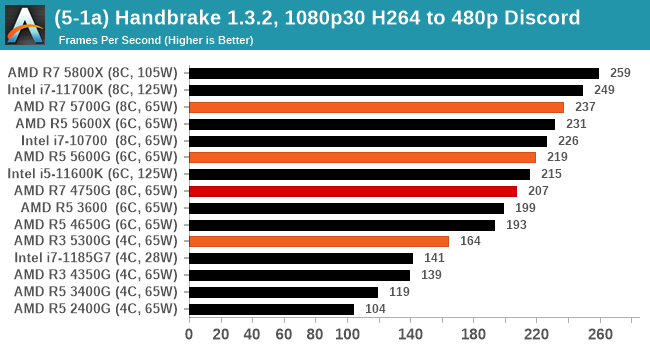
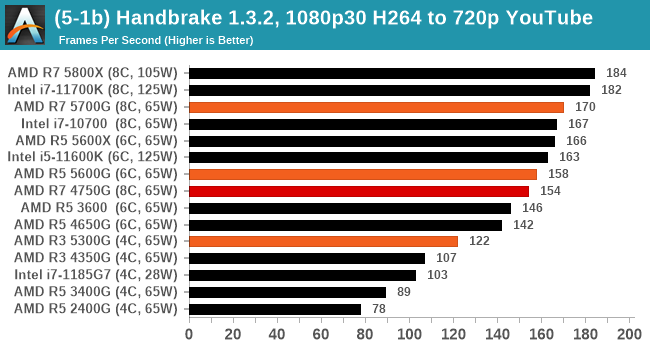
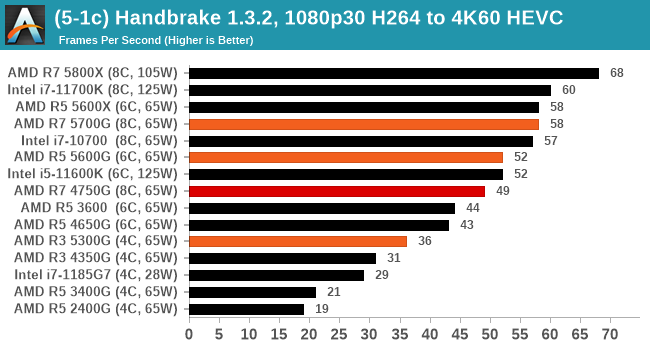
7-Zip 1900: Link
The first compression benchmark tool we use is the open-source 7-zip, which typically offers good scaling across multiple cores. 7-zip is the compression tool most cited by readers as one they would rather see benchmarks on, and the program includes a built-in benchmark tool for both compression and decompression.
The tool can either be run from inside the software or through the command line. We take the latter route as it is easier to automate, obtain results, and put through our process. The command line flags available offer an option for repeated runs, and the output provides the average automatically through the console. We direct this output into a text file and regex the required values for compression, decompression, and a combined score.

AES Encoding
Algorithms using AES coding have spread far and wide as a ubiquitous tool for encryption. Again, this is another CPU limited test, and modern CPUs have special AES pathways to accelerate their performance. We often see scaling in both frequency and cores with this benchmark. We use the latest version of TrueCrypt and run its benchmark mode over 1GB of in-DRAM data. Results shown are the GB/s average of encryption and decryption.
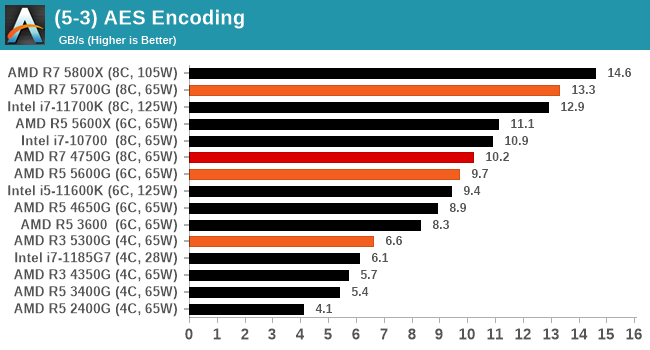
WinRAR 5.90: Link
For the 2020 test suite, we move to the latest version of WinRAR in our compression test. WinRAR in some quarters is more user friendly that 7-Zip, hence its inclusion. Rather than use a benchmark mode as we did with 7-Zip, here we take a set of files representative of a generic stack
- 33 video files , each 30 seconds, in 1.37 GB,
- 2834 smaller website files in 370 folders in 150 MB,
- 100 Beat Saber music tracks and input files, for 451 MB
This is a mixture of compressible and incompressible formats. The results shown are the time taken to encode the file. Due to DRAM caching, we run the test for 20 minutes times and take the average of the last five runs when the benchmark is in a steady state.
For automation, we use AHK’s internal timing tools from initiating the workload until the window closes signifying the end. This means the results are contained within AHK, with an average of the last 5 results being easy enough to calculate.



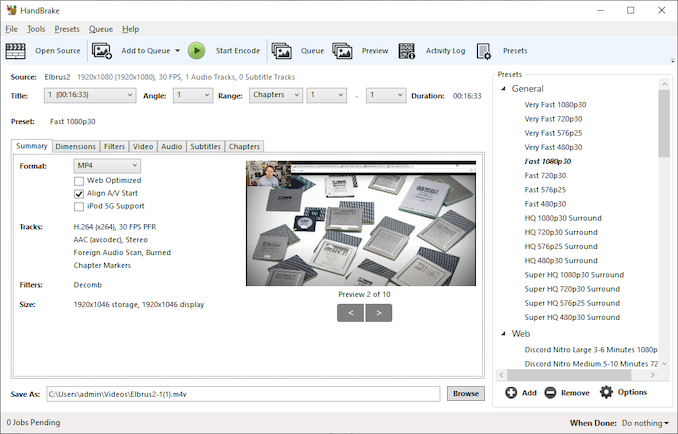
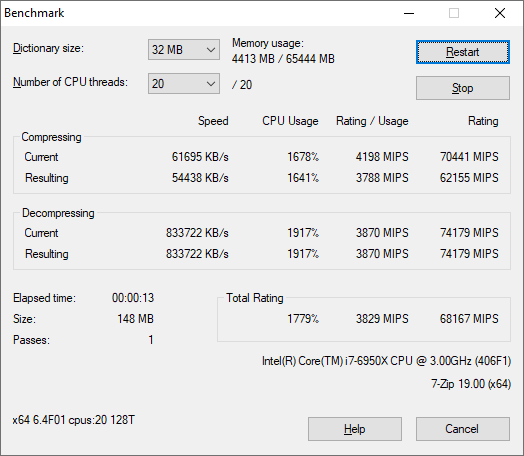
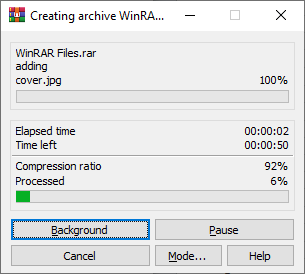








135 Comments
View All Comments
abufrejoval - Thursday, August 5, 2021 - link
There are indeed so many variables and at least as many shortages these days. And it's becoming a playground for speculators, who are just looking for such fragilities in the suppy chain to extort money.I remember some Kaveri type chips being sold by AMD, which had the GPU parts chopped off by virtue of being "borderline dies" on a round 300mm wafer. Eventually they also had enough of these chips with the CPU (and SoC) portion intact, to sell them as a "GPU-less APU".
Don't know if the general layout of the dies allows for such "halflings" on the left or right of a wafer...
mode_13h - Wednesday, August 4, 2021 - link
Ian, please publish the source of 3DPM, preferably to github, gitlab, etc.mode_13h - Wednesday, August 4, 2021 - link
For me, the fact that 5600X always beats 5600G is proof that the non-APUs' lack of an on-die memory controller is no real deficiency (nor is the fact that the I/O die is fabbed on an older process node).GeoffreyA - Thursday, August 5, 2021 - link
The 5600X's bigger cache and boost could be helping it in that regard. But, yes, I don't think the on-die memory controller makes that much of a difference compared to the on-package one.mode_13h - Friday, August 6, 2021 - link
I wrote that knowing about the cache difference, but it's not going to help in all cases. If the on-die memory controller were a real benefit over having it on the I/O die, I'd expect to see at least a couple benchmarks where the 5600G outperformed the 5600X. However, they didn't switch places, even once!I know the 5600X has a higher boost clock, but they're both 65W and the G has a higher base frequency. So, even on well-threaded, non-graphical benchmarks, it's quite telling that the G can never pass the X.
GeoffreyA - Friday, August 6, 2021 - link
Remember how the Core 2 Duo left the Athlon 64 dead on the floor? And that was without an on-die MC.mode_13h - Saturday, August 7, 2021 - link
That's not relevant, since there were incredible differences in their uArch and fab nodes.In this case, we get to see Zen 3 cores on the same manufacturing process. So, it should be a very well-controlled comparison. Still not perfect, but about as close as we're going to get.
Also, the memory controller is in-package, in both cases. The main difference of concern is whether or not it's integrated into the 7 nm compute die.
GeoffreyA - Saturday, August 7, 2021 - link
In agreement with what you are saying, even in my first comment. I think Cezanne shows that having the memory controller on the package gets the critical gains (vs. the old northbridge), and going onto the main die doesn't add much more.As for K8 and Conroe, I always felt it was notable in that C2D was able to do such damage, even without an IMC. Back when K8 was the top dog, the tech press used to make a big deal about its IMC, as if there were no other improvements besides that.
mode_13h - Sunday, August 8, 2021 - link
One bad thing about moving it on-die is that this gave Intel an excuse to tie ECC memory support to the CPU, rather than just the motherboard. I had a regular Pentium 4 with ECC memory, and all it required was getting a motherboard that supported it.As I recall, the main reason Intel lagged in moving it on-die is that they were still flirting with RAMBUS, which eventually went pretty much nowhere. At work, we built one dual-CPU machine that required RAMBUS memory, but that was about the only time I touched the stuff.
As for the benefits of moving it on-die, it was seen as one of the reasons Opteron was able to pull ahead of Pentium 4. Then, when Nehalem eventually did it, it was seen as one of the reasons for its dominance over Core 2.
GeoffreyA - Sunday, August 8, 2021 - link
Intel has a fondness for technologies that go nowhere. RAMBUS was supposed to unlock the true power of the Pentium 4, whatever that meant. Well, the Willamette I used for a decade had plain SDRAM, not even DDR. But that was a downgrade, after my Athlon 64 3000+ gave up the ghost (cheapline PSU). That was DDR400. Incidentally, when the problems began, they were RAM related. Oh, those beeps!